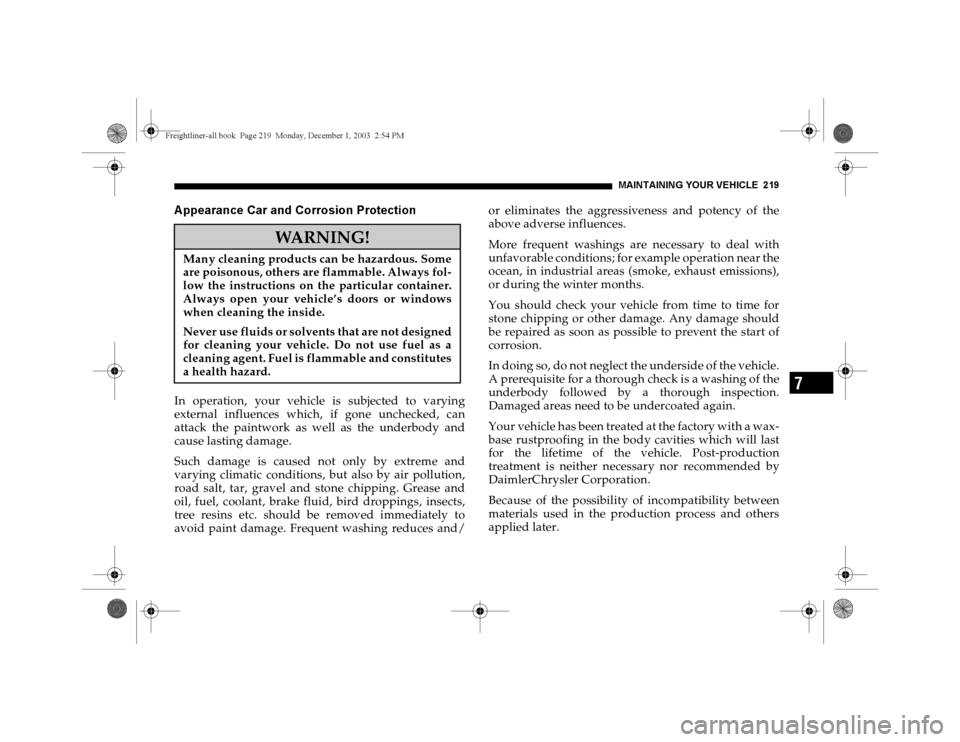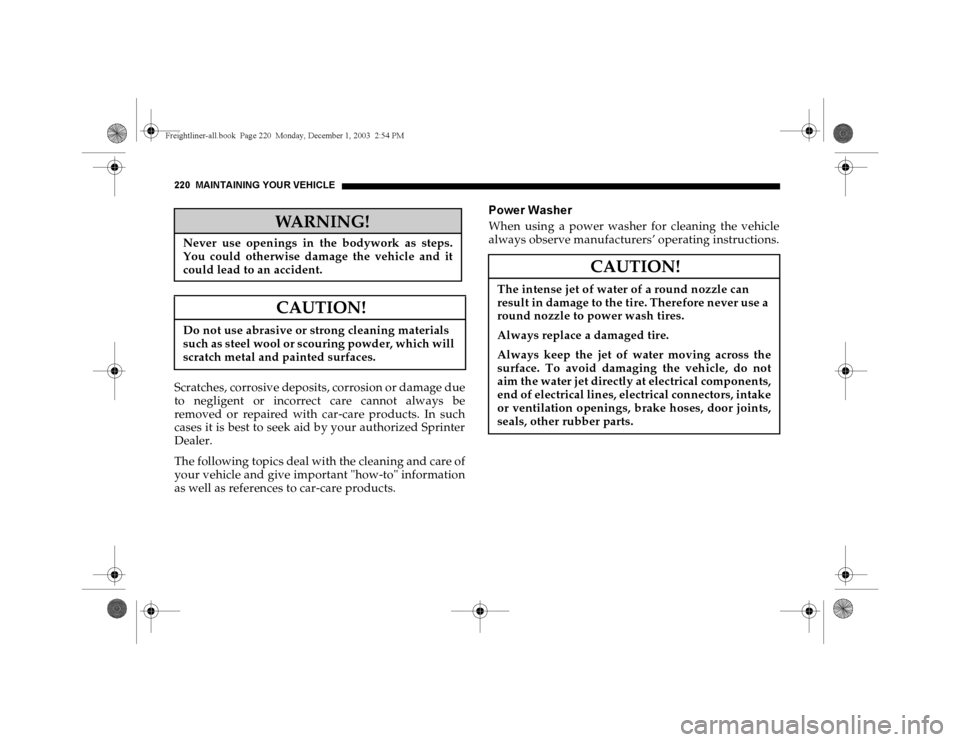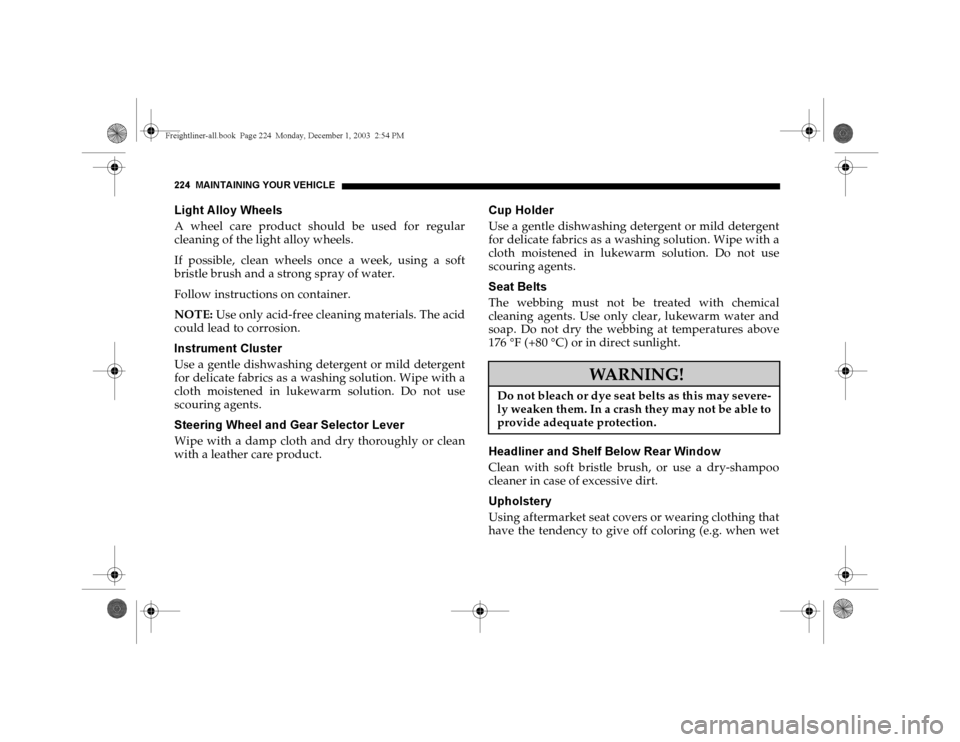2004 DODGE SPRINTER warning
[x] Cancel search: warningPage 214 of 272

214 MAINTAINING YOUR VEHICLE
Open the hood.
At first, only turn the radiator cap to the first detent
to release the pressure from the cooling system.
Only then should the radiator cap be removed
completely.
To add coolant:
If the engine is cold:
Add coolant until the coolant level reaches the base
area which is visible through the filler opening (area
moistened).
If the engine is already at its regular operating
temperature:
Add coolant until the coolant level is about 0.6 inch
WARNING!
In order to avoid any possibly serious burns:
If you see flames or smoke coming from the
engine compartment, or if the coolant
temperature gauge indicates that the engine is
overheated, do not open the hood. Move away
from the vehicle and do not open the hood until
the engine has cooled. If necessary, call the fire
department.
Do not remove pressure cap on coolant reservoir
if engine temperature is above 194 °F (+90 ×C).
Allow engine to cool down before removing cap.
The coolant reservoir contains hot fluid and is
under pressure.
Using a rag, slowly open cap approximately 1/2
turn to relieve excess pressure. If opened
immediately, scalding hot fluid and steam will
be blown out under pressure.
Do not spill antifreeze on hot engine parts.
Antifreeze contains ethylene glycol which may
burn if it comes into contact with hot engine
parts.
Check coolant level only with the engine
switched off and the key in position 0 in the
ignition lock.
Freightliner-all.book Pag e 214 Monday, December 1, 2003 2:54 PM
Page 216 of 272

216 MAINTAINING YOUR VEHICLEBA TTERIESThe standard battery is located in the engine
compartment.The auxiliary battery is located underneath the front
passenger seat (optional equipment).
The battery will not achieve its maximum service life
unless it is kept adequately charged at all times. If the
vehicle is used primarily for short distances, or left
parked for lengthy periods, have the battery charge
checked more frequently.
Disconnecting the Battery
WARNING!
Failure to follow these instructions can result in
severe personal injuries and death.
Never lean over batteries while connecting, you
might get injured, if the battery explodes.
Battery fluid contains sulfuric acid. Do not allow
this fluid to come in contact with eyes, skin or
clothing. In case it does, immediately flush
affected area with water and seek medical help if
necessary.
A battery will also produce hydrogen gas, which
is flammable and explosive. Keep flames or
sparks away from battery, avoid improper
connection of jumper cables, smoking etc.
Use only impact-resistant batteries with a central
gas release cover to prevent corrosion damage and
to prevent occupants from caustic burns in the
event of an accident.
CAUTION!
Do not loosen or remove the battery terminal
clamps while the engine is running or the key is in
the ignition lock as this could damage electrical or
electronic equipment beyond repair. All electrical
consumers must be switched off.
Do not place any metal objects on the battery.
Doing so may cause a short-circuit.
Loosen and remove the negative terminal clamp
first, then the positive terminal.
Afterwards disconnect vent tube from the fitting.
Freightliner-all.book Pag e 216 Monday, December 1, 2003 2:54 PM
Page 219 of 272

MAINTAININ G YOUR VEHICLE 219
7
A ppearance Car and Corrosion ProtectionIn operation, your vehicle is subjected to varying
external influences which, if gone unchecked, can
attack the paintwork as well as the underbody and
cause lasting damage.
Such damage is caused not only by extreme and
varying climatic conditions, but also by air pollution,
road salt, tar, gravel and stone chipping. Grease and
oil, fuel, coolant, brake fluid, bird droppings, insects,
tree resins etc. should be removed immediately to
avoid paint damage. Frequent washing reduces and/or eliminates the aggressiveness and potency of the
above adverse influences.
More frequent washings are necessary to deal with
unfavorable conditions; for example operation near the
ocean, in industrial areas (smoke, exhaust emissions),
or during the winter months.
You should check your vehicle from time to time for
stone chipping or other damage. Any damage should
be repaired as soon as possible to prevent the start of
corrosion.
In doing so, do not neglect the underside of the vehicle.
A prerequisite for a thorough check is a washing of the
underbody followed by a thorough inspection.
Damaged areas need to be undercoated again.
Your vehicle has been treated at the factory with a wax-
base rustproofing in the body cavities which will last
for the lifetime of the vehicle. Post-production
treatment is neither necessary nor recommended by
DaimlerChrysler Corporation.
Because of the possibility of incompatibility between
materials used in the production process and others
applied later.
WARNING!
Many cleaning products can be hazardous. Some
are poisonous, others are flammable. Always fol-
low the instructions on the particular container.
Always open your vehicle’s doors or windows
when cleaning the inside.
Never use fluids or solvents that are not designed
for cleaning your vehicle. Do not use fuel as a
cleaning agent. Fuel is flammable and constitutes
a health hazard.
Freightliner-all.book Pag e 219 Monday, December 1, 2003 2:54 PM
Page 220 of 272

220 MAINTAINING YOUR VEHICLEScratches, corrosive deposits, corrosion or damage due
to negligent or incorrect care cannot always be
removed or repaired with car-care products. In such
cases it is best to seek aid by your authorized Sprinter
Dealer.
The following topics deal with the cleaning and care of
your vehicle and give important "how-to" information
as well as references to car-care products.
Power WasherWhen using a power washer for cleaning the vehicle
always observe manufacturers’ operating instructions.
WARNING!
Never use openings in the bodywork as steps.
You could otherwise damage the vehicle and it
could lead to an accident.
CAUTION!
Do not use abrasive or strong cleaning materials
such as steel wool or scouring powder, which will
scratch metal and painted surfaces.
CAUTION!
The intense jet of water of a round nozzle can
result in damage to the tire. Therefore never use a
round nozzle to power wash tires.
Always replace a damaged tire.
Always keep the jet of water moving across the
surface. To avoid damaging the vehicle, do not
aim the water jet directly at electrical components,
end of electrical lines, electrical connectors, intake
or ventilation openings, brake hoses, door joints,
seals, other rubber parts.
Freightliner-all.book Pag e 220 Monday, December 1, 2003 2:54 PM
Page 221 of 272

MAINTAININ G YOUR VEHICLE 221
7
A utomatic Car WashIf the vehicle is very dirty, prewash it before you drive
into the car wash.
Fold in the exterior mirrors before washing the vehicle
in an automatic car wash and make sure that the
windshield wiper switch is in position 0.
The exterior mirrors and windshield wipers could
otherwise be damaged.
Make sure that mirrors are fully folded out after
leaving the automatic car wash.
Tar StainsQuickly remove tar stains before they dry and become
more difficult to remove. A tar remover is
recommended.Paintwork, Painted Body ComponentsPaint care should be applied when water drops on the
paint surface do not "bead up", normally every 3 to
5 months, depending on climate and washing
detergent used.
Paint cleaner should be applied if paint surface shows
signs of dirt embedding (i.e. loss of gloss).
Do not apply any of these products or wax if your
vehicle is parked in the sun or if the hood is still hot.
Use the appropriate paint stick for quick and
provisional repairs of minor paint damage (i.e., chips
from stones, vehicle doors etc.).Engine Cleaning Prior to cleaning the engine compartment, make sure
to protect electrical components and connectors from
the intrusion of water and cleaning agents.
WARNING!
Smears impair visibility, which is impaired fur-
ther by unfavourable conditions (e.g. fog, dark-
ness, driving snow).
If a wax preservative is sprayed on after washing
the vehicle, wipe off the wax from the windshield
and the wiper blade rubbers. This will prevent
smears forming on the windshield.
Freightliner-all.book Pag e 221 Monday, December 1, 2003 2:54 PM
Page 222 of 272

222 MAINTAINING YOUR VEHICLECorrosion protection, such as anticorrosion wax
should be applied to the engine compartment after
every engine cleaning. Before applying, all control
linkage bushings and joints should be lubricated. The
poly-V-belt and all pulleys should be protected from
any wax.Vehicle WashingDo not use hot water or wash your vehicle in direct
sunlight. Use only a mild car wash detergent.
Thoroughly spray the vehicle with a diffused jet of
water. Direct only a very weak spray towards the
ventilation intake. Use plenty of water and rinse the
sponge and chamois frequently.
Rinse with clear water and thoroughly wipe dry with a
chamois. Do not allow cleaning agents to dry on the
finish.
Due to the width of the vehicle, prior to running the
vehicle through an automatic car wash, fold back the
outside mirrors to prevent them from getting
damaged.
In the winter, thoroughly remove all traces of road salt
as soon as possible.When washing the underbody, do not forget to clean
the inner sides of the wheels.
Ornamental MoldingsFor regular cleaning and care of very dirty chrome-
plated parts, use a chrome cleaner.Headlamps, Taillamps, Turn Signal LensesUse a mild car wash detergent with plenty of water.
To prevent scratches, never apply strong force and use
only a soft, non-scratchy cloth when cleaning the
lenses. Do not attempt to wipe dirty lenses with a dry
cloth or sponge.
WARNING!
Dirty or iced-up steps and entrances create a risk
of slipping or falling.
Keep steps, entrances and footwear free from dirt
(e.g. mud, clay, snow and ice).
Freightliner-all.book Pag e 222 Monday, December 1, 2003 2:54 PM
Page 223 of 272

MAINTAININ G YOUR VEHICLE 223
7
Window CleaningUse a window cleaning solution on all glass surfaces.
An automotive glass cleaner is recommended.
There are 2 steps in the front bumper. This makes it
easier to clean the windshield.
Wiper BladeClean the wiper blade rubber with a clean cloth and
detergent solution.
WARNING!
For safety reasons, remove key from ignition lock
before cleaning the windshield, otherwise the
wiper motor can suddenly turn on and cause in-
jury.
Dirty or iced-up steps create a risk of slipping or
falling. Do not use the step in the front bumper
when it is icy or dirty.
WARNING!
For safety reasons, remove key from ignition lock
before cleaning the wiper blade, otherwise the
wiper motor can suddenly turn on and cause se-
vere personal injuries and death.
Freightliner-all.book Pag e 223 Monday, December 1, 2003 2:54 PM
Page 224 of 272

224 MAINTAINING YOUR VEHICLELight A lloy WheelsA wheel care product should be used for regular
cleaning of the light alloy wheels.
If possible, clean wheels once a week, using a soft
bristle brush and a strong spray of water.
Follow instructions on container.
NOTE: Use only acid-free cleaning materials. The acid
could lead to corrosion.Instrument ClusterUse a gentle dishwashing detergent or mild detergent
for delicate fabrics as a washing solution. Wipe with a
cloth moistened in lukewarm solution. Do not use
scouring agents.Steering Wheel and Gear Selector LeverWipe with a damp cloth and dry thoroughly or clean
with a leather care product.
Cup HolderUse a gentle dishwashing detergent or mild detergent
for delicate fabrics as a washing solution. Wipe with a
cloth moistened in lukewarm solution. Do not use
scouring agents.Seat BeltsThe webbing must not be treated with chemical
cleaning agents. Use only clear, lukewarm water and
soap. Do not dry the webbing at temperatures above
176
°F (+80
°C) or in direct sunlight.
Headliner and Shelf Below Rear WindowClean with soft bristle brush, or use a dry-shampoo
cleaner in case of excessive dirt.UpholsteryUsing aftermarket seat covers or wearing clothing that
have the tendency to give off coloring (e.g. when wet
WARNING!
Do not bleach or dye seat belts as this may severe-
ly weaken them. In a crash they may not be able to
provide adequate protection.
Freightliner-all.book Pag e 224 Monday, December 1, 2003 2:54 PM